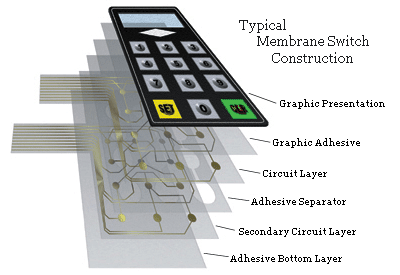Find out about the Ingenious Manufacturing Techniques Behind Membrane Switches
Find out about the Ingenious Manufacturing Techniques Behind Membrane Switches
Blog Article
The Ultimate Source on Membrane Layer Switches Over: Design, Capability, and Applications
Membrane switches serve as a fascinating junction of style and performance, playing a critical function in modern user interfaces across different sectors. As we discover the diverse applications of membrane layer switches, it comes to be noticeable that their adaptability and durability are vital in settings varying from medical care to consumer electronic devices.

Comprehending Membrane Switches
Membrane layer switches are a type of interface modern technology extensively used in different digital tools, identified by their slim, flexible style and performance. These buttons contain multiple layers that include visuals overlays, adhesive layers, and wiring, allowing a effective and portable user interface for individuals. They can be discovered in home appliances, clinical tools, and industrial control board, providing a trustworthy technique for user communication.
One of the main advantages of membrane layer switches is their capability to stand up to pollutants such as dirt and dampness, making them ideal for environments where sturdiness is crucial. Their low-profile design permits smooth integration into different applications, while the adjustable visuals overlays boost individual experience by providing clear aesthetic feedback. In addition, membrane layer buttons can fit a variety of innovations, such as responsive feedback and backlighting, more enhancing their usability.
The manufacturing procedure for membrane layer switches over normally includes screen printing, lamination, and die-cutting strategies, guaranteeing precision and uniformity in manufacturing. Generally, membrane layer switches over stand for a versatile and effective option for contemporary digital tools, incorporating capability with aesthetic allure in interface style.
Secret Parts and Design Components
A selection of essential parts and style aspects collaborated to create an efficient membrane layer switch. At the core, the graphic overlay serves both visual and functional objectives, supplying an easy to use interface while shielding internal parts from ecological elements. The selection of products, typically polyester or polycarbonate, affects toughness and responsive feedback.
Below the overlay, the sticky layer ensures the switch adheres firmly to the substrate, which can be glass, plastic, or metal. The spacer layer is crucial, as it keeps the required space between the overlay and the circuit layers, enabling reliable actuation. Membrane Switches. Circuit traces, normally made from conductive ink or adhesive, are published on an adaptable substrate, allowing electrical signals to be transferred when stress is applied
Design factors to consider additionally consist of the setup of responsive domes or embossing that provide physical comments to the user, boosting the overall experience. Furthermore, the format and spacing of the buttons have to be maximized for convenience of usage, making sure that individuals can navigate the user interface without effort. On the whole, these elements and design elements work synergistically to create a reliable, functional membrane button tailored to specific applications.
Performance and Operation Device
At the heart of reliable capability for membrane layer switches over lies their functional system, which promotes customer interaction via an easy yet efficient layout. These switches operate on the concept of pressure activation, where a customer applies pressure to a designated location of the button (Membrane Switches). This action presses the layers of the button, finishing an electrical circuit that sends out a signal to the connected gadget
The building and construction typically consists of a leading visuals layer, an adhesive spacer layer, and a lower circuit layer, which collectively develop a durable user interface. When pressure is used, the top layer breaks down versus the bottom circuit layer, allowing conductive traces to link. This style not only enables clear tactile responses yet additionally ensures sturdiness and dependability, as the buttons are frequently resistant to dirt and dampness.
In addition, the flexibility of membrane changes permits combination with numerous technologies, consisting of LED indications and microcontrollers, boosting their functionality. By supplying a streamlined interface that decreases mechanical wear, membrane layer changes remain a preferred option in applications varying from customer electronics to commercial tools, ensuring ideal performance and individual satisfaction across varied environments.
Sorts Of Membrane Buttons

Another considerable group is brightened membrane layer buttons, which include backlighting to improve visibility in low-light conditions. These switches are typically used in control panels and dashboards where clear visibility is necessary.
Furthermore, there are custom membrane layer changes developed to satisfy particular dimensional, graphical, and practical requirements. These modifications can consist of unique shapes, colors, and designs, permitting smooth combination into different devices.

Applications Throughout Different Industries
Just how do membrane buttons improve capability across varied sectors? In the medical sector, membrane layer switches play a vital duty in devices such as diagnostic equipment and client monitoring systems, where integrity and convenience of cleansing are vital.
In the vehicle market, membrane layer buttons are typically made use of in control panels and control board, giving instinctive controls that improve vehicle driver safety and comfort. The customer electronic devices industry likewise takes advantage of their adjustable and lightweight functions, making it possible for sleek layouts for mobile phones and home appliances.
Additionally, membrane switches locate applications in commercial automation, where they add to efficient machinery operation and tracking systems. Their resistance to dust and wetness guarantees capability sought after problems (Membrane Switches). Furthermore, the food and drink sector uses membrane layer switches for devices control, where health and toughness are vital
Final Thought
In verdict, membrane switches over look at this site represent an essential technology in individual interface technology, identified by their one-of-a-kind layout and capability. The adaptability of membrane switches promotes their application throughout varied sectors, from clinical devices to customer electronic devices.
Membrane switches over offer as an appealing intersection of design and capability, playing a pivotal duty in modern-day user interfaces across numerous sectors.Membrane layer switches are a kind of customer interface modern technology widely used in various electronic devices, characterized by their slim, flexible design Get the facts and performance.At the heart of effective performance for membrane switches exists their functional mechanism, which promotes customer interaction through a straightforward yet effective layout. These switches operate on the principle of pressure activation, where a customer applies force to a designated area of the button.In verdict, membrane switches stand for a crucial technology in customer interface innovation, defined by their unique design and functionality.
Report this page